Saturday, September 29: Arrived in Barcelona to rain at 7:30 am. Travelled Executive Class on Air Canada. The seats fold down into beds. It’s like sleeping in an open coffin.![]()
At my hotel called ME I slept for five hours. Walking the corridor to my room is like travelling through a huge cheese grater. Interesting panel of push buttons in the room that operate the lights and the blackout curtains. Slept five hours and awoke refreshed.
At 8:30 pm the media guests are bussed to the Palauet Albénitz, an impressive marble-floored castle for a reception hosted by the mayor of Barcelona, Xavier Trias, and stand-up dinner. We are handed a glass of Torres Waltraud Riesling 2011 as we enter the hall. There is a table of a range of Torres wines.
Sunday, September 30: Up at 8 am having slept thanks to melatonin. The first Wine & Culinary International Forum is held in the Sky Room of the hotel. Miguel Torres opens the event, welcoming the participants from around the world – 36 foreign journalists and 26 from Spain. The rest of the audience are restaurateurs and sommeliers – in total 240 of us. The reason Miguel Torres created this symposium: “to recognise the success of Catalan cuisine around the world.” Big challenges ahead of us, he says, climate change and the relating of wine to other alcoholic beverages.

Miguel Torres
The first session is entitled “Sommelier, a risky profession: my boldest matches”: Josep Roca, sommelier and co-owner with his two brothers, Joan and Jordi, of the three-star restaurant El Celler de Can in Girona. He spoke of the use of spirits and tea in the preparation of dishes. Synopsis: “I need to be able to play with wines, like literature or music. I like to be bold, change the rhythm, even the mood. The best pairing is not always the ideal pairing. It’s better to have a pairing that evokes an emotional response. We have to manage our vanity, the perfect is not always that’s best for the customer.” Some of his bolder matches: Figs with Cariena from Priotat. Difference in sliced or cubed ham: one with dry sherry the other fino . When you have lettuce with red wine you react with your saliva to the wine. Tannic wines should be of low alcohol. Participants were given a sample of port (Dow’s 1961) to represent nostalgia for the past.
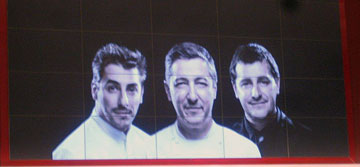
The Roca brothers
Second session: “Taste Buds & Molecules – The aromatic science of Food & Wine”: Montrealer François Chartier, sommelier, writer and researcher in molecular science, started his address with a film of Jimi Hendrix, drawing a parallel between the innovative guitarist and the leading chefs in the 1960s who have changed how we understand gastronomy. “I have to taste to believe,” he says. He alluded to certain ingredients that can be called liaisons, that have aromatic synergy, like Syrah and black olives. “We want to generate the Wow effect. Sauvignon Blanc and mint. There are in mint 4 or 5 molecules that have an anise taste. In tomato – 400 molecules only 16 that define the aroma. Coffee – 800 aromatic molecules but only 27 that create the aromatic profile. Fresh mint and parsley in tabouli have anise molecules as does Sauvignon Blanc.” We were served Hugel Riesling 2007 with a paella foam with saffron and Quebec cider. François alluded to fenugreek tasting like maple syrup. We tasted Torres Mas La Plana 2003 with beef slightly burnt with a puree of red pepper and sesame oil. A truly virtuoso performance that riveted the audience of 240 sommeliers and writers. Even Jancis Robinson took notes.
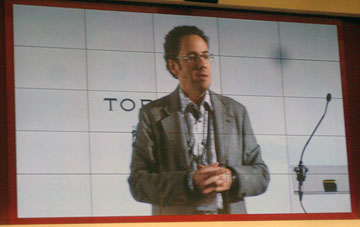
François Chartier
Third session: “The Pairing Topics” – a round table discussion with Markus del Monego (German master sommelier and MW), Linda Milagros Violago (Canadian sommelier who worked at Charlie Trotter now at Geranium restaurant in Denmark) and Johan Agrell (sommelier and co-owner of Fäviken in Sweden). Johan: A Russian started the concept of matching food and wine 200 years ago. What is the best food and wine match? Linda: I have an instinctual approach. Markus: The sommelier and the chef should work together. Linda: I’m not a great fan of wine pairing, matching 12 wines to 12 courses. I don’t believe there’s the one right wine for every single dish. Not the most satisfactory session as little of value to the audience came out of it.
Session Four: Show Cooking – Javier and Sergio Torres (chefs at Dos Cielos in Barcelona). “Our philosophy is to receive and share. We bring ingredients from Brazil and the Amazon.” The brothers demonstrated how they prepared the lunch we are about to have. Outside the lunch room were tables set with virtually the entire Torres portfolio, including the wines from the Marimar Estate in Sonoma. Marimar Torres’s daughter Cristina was pouring the wines. The series of five Pinot Noirs from different vineyards showed that there are definite terroir differences in the sites.
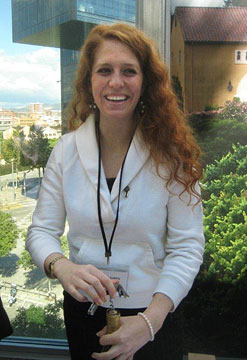
Cristina Torres
The lunch menu:
Aperitifs were prepared by Paco Perez, chef at the two-star Miramar restaurant in Llançà – Chicken in pepitoria sauce, nuts and dried fruits dunkin’ (in the shape of tiny donuts), Niçoise salad, shrimp nigri, with Torres Fransola 2011 (Sauvignon Blanc)
Cream of tabella beans with tuber uncinatum, with Torres Gran Vina Sol 2011
Surf and turf with catch of the day: St. Peter fish with a beef reduction, rosemary salt and leeks (fish cooked in the vapour from the salt), with Torres Gran Sangre de Toro 2008
Sous vide goat kid shoulder with salt and pepper char-grilled at 78 degrees, with Torres Mas La Plana 2007 (from magnum) and Jean Leon Vinya La Scala Gran Reserva 2001
Black Forest gâteau, with Torres Priorat Perpetua 2010
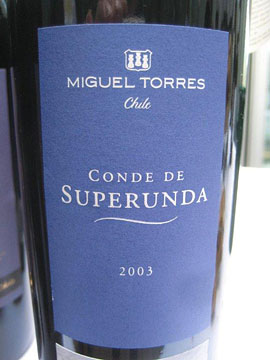
Superunda – a super wine
The first speaker after lunch was Alain Senderens, former chef of Lucas Carton (the only restaurant where I’ve ever sent a wine back in Paris – it was corked and I got an argument from the waiter). For his current restaurant, called Senderens, he gave up his three Michelin stars to create haute cuisine available to all. Here are some of his quotes: “The pairing of food and wine is the future of cuisine.” “I’m a person who doesn’t trust aromas if there are too many of them. The texture of the food and the volume in the mouth is more important to me.” “Wine is the master of ceremonies that commands the tone. If I can find the wine I can build a dish around it. Wine allows us to do what we want to with the dish.” “We tried Croton-Charlemagne with oysters but we found that Muscat was the best.”
Second session after lunch: “Pairing Emotions – Time Travel through Peru”: Gaston Acurio, Peruvian chef from Lima, a city known as the gastronomic capital of South America. There are, apparently, 80,000 students of cuisine in Lima. He spoke of the five ingredients that were available thousands of years ago. Potatoes, tomatoes, corn, black beans and eggs. Peru has 2000 varieties of potato. Ceviche, a flagship dish in Peru, is a concept rather than a dish. You can make it from a variety of ingredients. We sampled one with shrimp, chili, cilantro, sea snail, beans, onions and roasted corn, served with Torres Fransola Sauvignon Blanc 2011.
Next session: “Wine in sweet cuisine”: Oriol Balaguer (best dessert and pastry chef in Spain in 2008) and Ferran Centelles (sommelier at El Bulli for 10 years). The theme was simplicity – less is more. Ferran: “21st century pairings are done in the kitchen.” Every month Oriol and his staff create a concept cake. We realized the more complex the cake was the more difficult to sell to clients and the more difficult to pair with wines. The milder the dish the easier to pair with wine. He gave a practical demonstration of the theory by serving three sets of two samples, one more highly spiced or concentrated than the other – two parmesan biscuits, one simple, the other with tomato and basil, served with Marimar Acero Chardonnay 2010; two white chocolates with lemon filling, the second more concentrated in lemon and sugar than the first, with Hugel Gewurztraminer Vendange Tardive 2005; and two chocolates, at 40% and 70% cocoa, served with Torres Cordillero Brut. We are asked to give our preference in terms of the wine matching of each pair. Overwhelmingly the participants voted for the simpler, less concentrated sample.
The next session: “Wine in the Restaurant” with Jancis Robinson, her husband Nick Lander (food critic for Financial Times of London) and Victor de la Serna (Spanish food critic). Nick: “More and more restaurant-goers are women. Young women decide where they (and their partners) are going to eat. Women tend to select dishes based on the vegetable content; men, the protein content.” Jancis: “Consumers and producers are getting wearied of restaurants who mark up wines to bankroll their establishments.”

Nick Lander, Jancis Robinson and Victor de la Serna
The Honourable Regional Counsellor for Agriculture, Fishing Industries, Food and Environmental issues, Josep Maria Pelegri, thanked Miguel Torres for creating and organizing the forum.
Finally, a tasting of ten wines from the Primum Familiae Vini conducted by Christophe Brunet. The PFV concept – a marketing association of leading family-owned wineries – was dreamed up in 1991 by Robert Drouhin and Miguel Torres.
- Marchesi Antinori Badia a Passignano 2007: deep ruby colour; cherry, spicy oak with a vanilla note; dry, elegant, firmly structure with bright acidity and a tobacco note. (89)
- Tenuta San Guido Guidalberto 2010 (60% Cabernet Sauvignon, 40% Merlot):dense ruby-purple colour; minerally, barnyard, pencil lead notes on the nose; dry, savoury, dry rose petal, firm structure, still tight but elegant. Great balance. (91+)
- Famille Perrin Château de Beaucastel 2007: deep ruby colour; spicy blackberry with a floral note; sweet fruit, fresh and lively with herbal and licorice notes; malt and dark chocolate notes on the finish; ripe tannins. (93)
- Vega Sicilia Alión 2009 (100% Tinto Fino): dense purple-ruby colour; floral, black cherry, pencil lead, evident oak on the nose; richly extracted, full on the palate, firm tannins still but rich and satisfying. (91+)
- Château Mouton-Rothschild Petit Mouton 2005 (60% Cabernet Sauvignon, 20% Merlot, 20% Cabernet Franc): dense ruby; tobacco, blackcurrant, cedar nose; light and elegant but firmly structured; apple and red berry flavours, a little short on the finish. (89)
- Bodegas Torres Grand Muralles 1998 (Carignan, Garnacha, Monastrell, Cinsault): dense ruby colour; lovely nose of blackcurrant, cedar; very earthy, dark chocolate and still tannic. (90)
- Pol Roger Brut 2002: nutty, apple puree, peach, brioche nose, yeasty; rich and very elegant, toasty, apple and citrus, winey. (92)
- Joseph Drouhin Chablis Les Clos 2008: light straw colour; minerally, apple nose; crisply dry, green apple and white peach flavours, great length with a fine acidic spine. (92)
- Egon Müller-Scharzhofberger Riesling Kabinett 2011: pale straw colour; minerally, grapefruit, oatmeal nose; off-dry, honey, grapefruit flavours with a touch of hardness on the finish but delicious. (89)
- Symington Family Estate Dow’s Senhora da Ribeira Vintages 1999: dense purple; blackberry, plum and licorice nose; sweet blackberry, black tea and kirsch flavours, lively acidity with a firm tannic finish. (91)
For the day’s tasting 9,000 Riedel glasses were used and only one was broken. I can’t believe that I sat through nearly twelve hours of listening to the speakers without getting bored or my mind wandering. A spectacular event. I opted for an early night without more food.

Tony and Miguel Torres
Monday, October 1: Awoke at 5 am and considered getting up but since we didn’t have to leave for a tour of the Torres facility in Vila Franca until 10 am decided to close my eyes again. When I opened them it was 9:30 am. Got up in a panic, quickly showered and made it in time for the bus.
The highlight of the day was the lunch at Mas Rabel, the old farmhouse 6 kilometres’ drive from the winery. Joan and Jordi Roca prepared the best lunch I have ever eaten. It began with a series of amuse bouches. A waiter came around with what looked like a bonsai olive tree from whose branches were hanging olives coated with an anchovy paste, then a waitress arrived with what looked like orange marbles – they were grapefruit and Campari frozen in balls. Then white truffle muffins that melted in the mouth.

Olive tree bonsai
First course: Salad of figs encrusted in baked milk on a fig leaf, served with Torre Fransola 2011
Second course: Sole meunière with toasted almond, lemon and the skin of the fish baked crisp and laid across the top with lavender flower, with Torres Milmanda Chardonnay 2008
Third course: Suckling pig with beetroot jam, melon juice and beetroot sprouts, with Torres Querol 2012 (a heritage variety saved from extinction by Torres; this is one of components in the Grans Muralles blend)
Fourth course: Lamb belly with mint, cheese and cumin, with Torres Manso de Valeco Cabernet Sauvignon 2007
Fifth course: Grilled goose with strawberry jam, cocoa and aromatic herbs, with Torres Grans Muralles 2001
Sixth course: Terrine of wild pigeon with gingerbread and curried, caramelized walnut, with Torres Mas La Plana 1977
First dessert: Dried apricot, candied orange, wine jelly with a “grey cloud” of spun sugar to represent botrytis, with Torres Nectaria 2009
Second dessert: Meringue in shape of a clam shell with caramel stick and cream. This was followed by petits fours and Torres Jaime 20-year-old Brandy
We were at the table for three and a half hours. Got back to the hotelby 7:15 pm. While some of the journalists went on to dinner at Torres’s Bistro in the city I opted to rest my stomach.
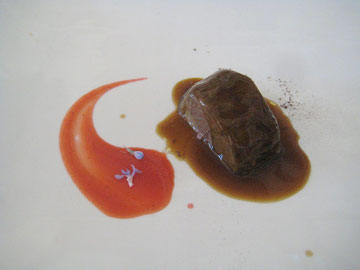
Grilled goose stuffed with foie gras
Tuesday, October 2: Up at 8 am, packed and had breakfast with François Chartier before we took a car to the airport with Mexican wine writer Rene Renteria. A mercifully uneventful flight home. Watched a terrible Hannibal Lecter movie titled Red Dragon. Deborah picked me up at the airport and I managed to stay up till 10:15 (4:15 am my body time) before crashing.
Wednesday, October 3: Spent the day catching up on emails (the curse of travelling) and then down to the Fermentation Cellar at the Distillery District for sip&Savour Ontario. Judged culinary teams from George Brown, Humber College and Ryerson with Jenny Longo and Susan Niczowski of Summer Fresh – on dishes they prepared and presented using Summer Fresh sauces. Then compered three cooking demonstrations featuring chefs who had competed in Top Chef Canada.
Thursday, October 4: At 11:30 am down to Lai Wah Heen in the Metropolitan Hotel for a food and wine matching lunch with Luisa Rose, the winemaker from Yalumba in the Barossa Valley. While we were having an aperitif I got to try Yalumba Octavius 2006, a Shiraz made from old vines and aged in octaves – 100-litre French and American barrels. (Dense purple-black in colour; a nose of vanilla, blackberry, black olive with a medicinal note; rich and savoury but elegant and surprisingly juicy, finishing with lively acidity – 93). When we sat down a series of dim sum dishes – steamed seafood, steamed poultry and deep fried – were put in front of us to be matched with pairs of Yalumba wines. Yalumba pioneered Viognier in Australia.
Steamed lobster and shrimp dumpling with garlic butter; steamed dumpling of crabmeat and vegetables and steamed shrimp dumpling, with Yalumba Organic Viognier 2011 (light straw colour; honeysuckle, peach nose with a touch of mint; light on the palate, fresh and elegant (89)) and Yalumba Y Series Viognier 2012 (minerally, honeysuckle nose; dry, fresh, peach pit flavour with a touch of bitterness on the finish (87))
Steamed lamb loin dumpling flavoured with cumin seeds; steamed dumpling of minced chicken and vegetables and steamed BBQ pork bun, with Yalumba Eden Valley Viognier 2012 (very elegant, delicate, spicy, dry, honeysuckle, tangerine and white peach flavours with a lemony finish (89)) and Yalumba The Virgilius Viognier 2009 (rich, oily, apricot nose; full on the palate, minerally, spicy and complex (92))
Deep-fried chicken ball with truffle sauce; deep-fried Berkshire pork and baby shrimp dumpling and deep-fried roll of dragon fruit, mango and shrimp, with Yalumba Y Series Shiraz Viognier 2010 (deep purple-ruby colour; spicy, rose and jammy raspberry nose; forward fruit, dry, raspberry flavour with a medicinal note and lively acidic finish (88)) and Yalumba Hand-Picked Eden Valley Shiraz + Viognier 2009 (dense purple colour; a nose of violets and raspberry jam, vanilla oak, mocha flavours; succulent and very elegant with great length (92+))
Crisp noodles with lobster and chicken scented with truffle
Dessert: Deep-fried sesame ball and Baked tart shell with egg custard, with Yalumba Botrytis Viognier 2012 (very pale colour; a nose of sweet raisins, honey, peach and apricot; sweet but light on balancing acidity (89))
Came home to taste some BC wines.
- Mt. Boucherie Family Estate Winery Estate Collection Gamay Noir 2010 (Okanagan Valley): Pale ruby colour with a nose of rhubarb and sour cherry; light on the palate, dry, minerally sour cherry flavour with a hint of mint, white pepper, a smoky note and a light spritz (87).
- Cassini Cellars Red Carpet Pinot Noir 2011 (Okanagan Valley): Deeply coloured; rustic, alcoholic nose, woodsy and pencil lead; on the palate sweet cooked fruit, milk chocolate and earthy flavours. Not much varietal character here and a touch volatile. Fermented for too long at a high temperature? (84)
- Cassini Cellars Merlot 2011 (Okanagan Valley): Deep ruby colour; vanilla oak, rustic, raspberry and blueberry nose; medium-bodied with lively acidity plum and clove flavours, finishing with green note and grainy tannins. (86)
- Cassini Cellars Pinot Gris 2011 (Okanagan Valley): Light straw colour; minerally, peach pit and almond nose; well extracted sweet peachy fruit, soft on the palate; medium-bodied and easy drinking. (88)
To dinner at Ruth’s Chris Steak House with Sergio Zingarelli, owner of Rocca delle Macie, Vito Candela, the marketing manager, and the importer Philip MIrabelli. A glass of Bottega Prosecco to start. During the dinner we tasted:
- Rocca delle Macie Vernaiolo Chianti 2011: ruby colour; a nose of cherries; medium-bodied, dry, firm structure; easy drinking with a cherry pit finish (87)
- Rocca delle Macie Chianti Classico 2010: deep ruby colour; cherry and oak on the nose; richly extracted, dry and firm. (88)
- Rocca delle Macie Ser Gioveto 2006 (80% Sangiovese with Merlot and Cabernet Sauvignon): rich plum, blackcurrant and cedar on the nose with a vanilla note; spicy, dark chocolate and licorice flavours, medium-bodied with soft tannins (91)
- Rocca delle Macie Roccato 2006 (Sangiovese and Cabernet Sauvignon): deep ruby colour; cedar, cherry nose; savoury, chunky mouth feel; firm structure and mouth-filling. (90)
Friday, October 5: Worked on the wine book all day, writing profiles of BC wineries. Dinner across the road at The Homeway (newly opened for dinner) with Deborah. This neighbourhood bistro serves great food at reasonable prices. With my jambalaya I opened a bottle of Montes Alpha Cabernet Sauvignon 2009 (dense purple colour; savoury, blackcurrant, cedar, mint and spice notes on the nose; richly extracted fruit, a majestic wine with a chocolate finish and velvet mouth feel (91)).

Tony,
Sounds a spectacular conference – thanks for the report. Did you find general agreement with the Senderes claim that the “matching of wine and food is the future of cuisine”? And how was that 1977 Mas de Plana?!
Nigel Bruce
We spend a lot of time thinking about hosting and all the stuff that goes along with
that from applications to servers and server software. Our attention tends to be focused on maintaining webpages and domain names,
but there are a lot of reasons you might be looking for a
host. Maybe, for example, you want to run a Call Of Duty
4 server.
Web games fall into various sub categories- email games, browser games, and multi player games.
Email games are by far the simplest- technically they aren’t web games and you don’t even need
a computer to moderate them, just to send and receive.
Browser games can be implemented in Flash, JavaScript (dhtml), Java and
even ActiveX/COM. I’d guess that most single player games are implemented in Flash but I’ll save that
for a future article. To start with, though I’ll take you through what is involved in developing Multiplayer Web Games.
Bandwidth is important to any business website. This relates to the number of customers who can visit your site at one time. You naturally never want to limit your traffic flow to your website, but if you are using a gamer shared server, you are probably doing that already. Because the shared server can only accommodate so much traffic, some of your customers may be experiencing trouble logging on to your website.
This is the top MMORPG game that motivates one to be an unbeatable dominator. Built entirely in Flash, this game is played in the browser, which offers three types of worlds packed with countless real players. While a majority of games need to be downloaded, Battle Dawn entices you with its user-friendly graphical user interface where you start your journey as the leader of a small settlement and spread your wings of sovereignty via diplomacy, great army, strategies. So, why not try your skills to outwit your enemies and make lasting friendships with your allies for ruling the world?
Depending on your budget and how associated you are in gaming, you can select from expensive and heap game servers. These can be rented alone, or you could bring together a team of gamers, make a clan and hire it out together. If you choose to build a group, you will have to appoint a leader to run the server. Since there are few people involved, everyone can chip in towards getting an expensive server for advanced gaming experience.
Group study is a lot easier using this type of application, as is planning family get togethers, or any other occasion where you need to allow multiple people to talk in real time, but don’t
have conference call capabilities. It’s a lot cheaper and easier than making multiple long distance calls, and it’s a lot
easier to organize things when you don’t have to relay information. Plus, there’s no per minute fee on Vent
servers, and they’re easy to use.
The other thing to remember is new games are released every day. There are so many niches within this niche as you could solely focus on one game and its community and still reach a huge audience from all over the world!
Listen Servers – These servers are connected through LAN and do not require the use of the internet. In this case a player can play the game and be the host at the same time as well. The flip side is that if the player is terminated from the game, so is the host.